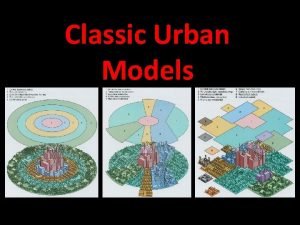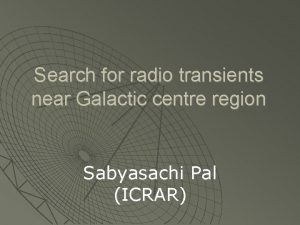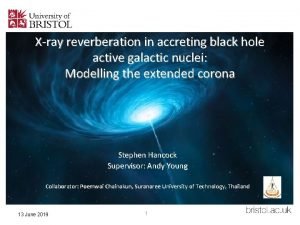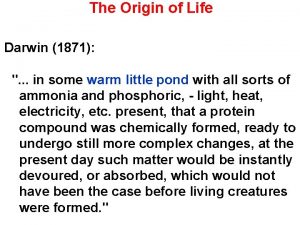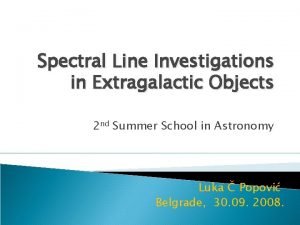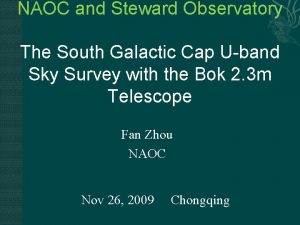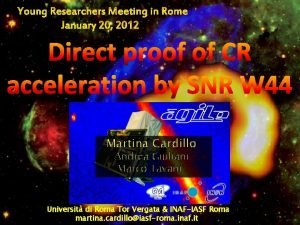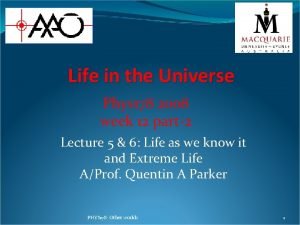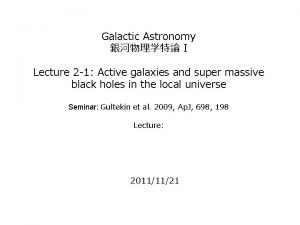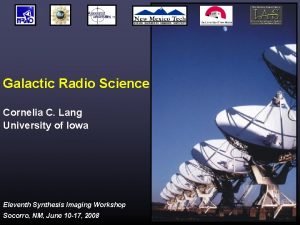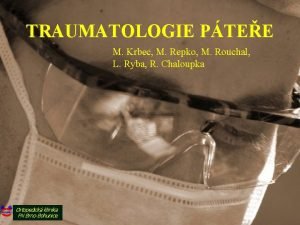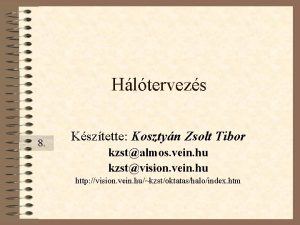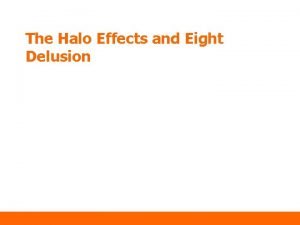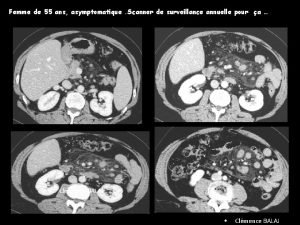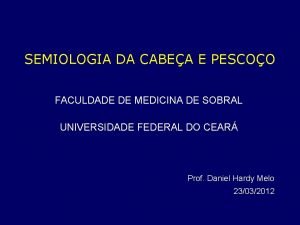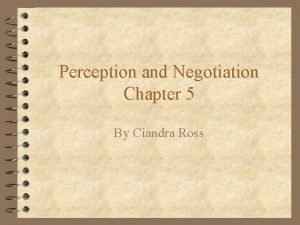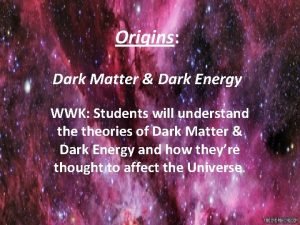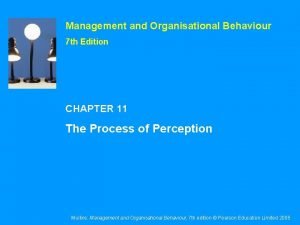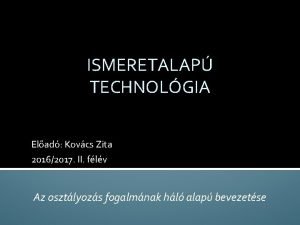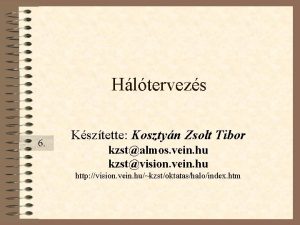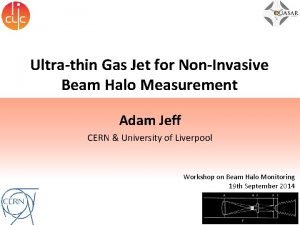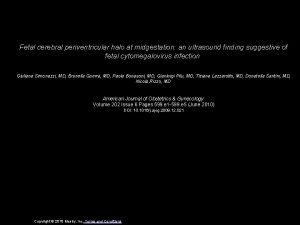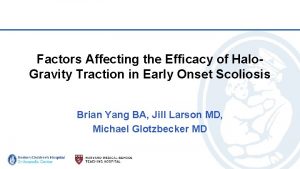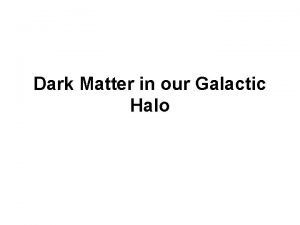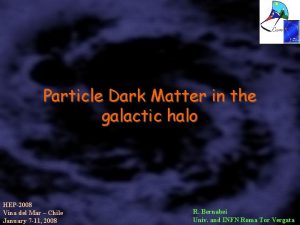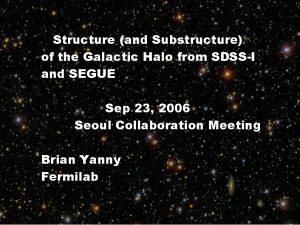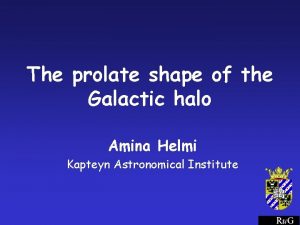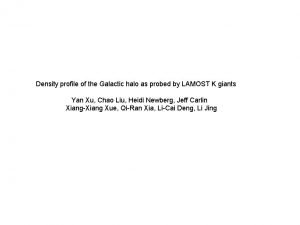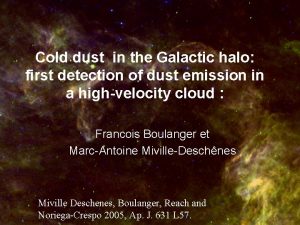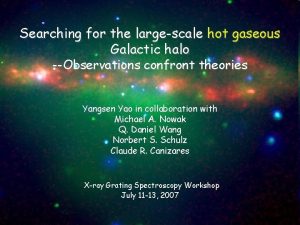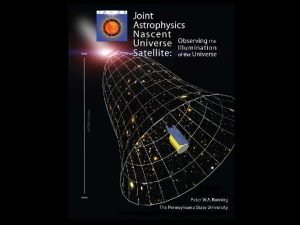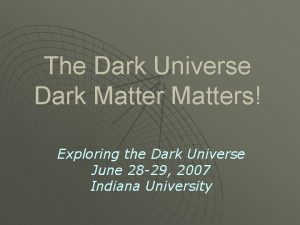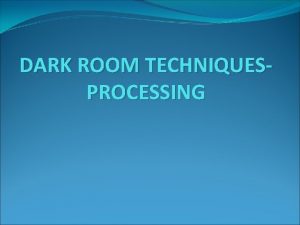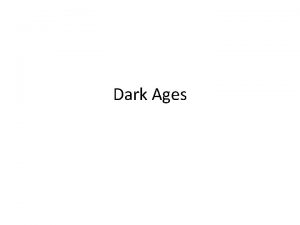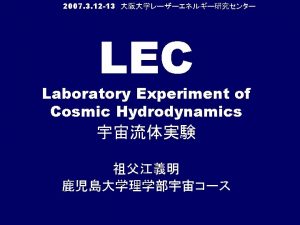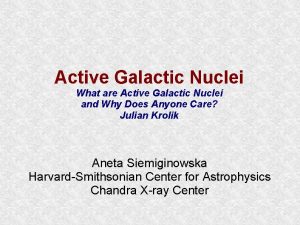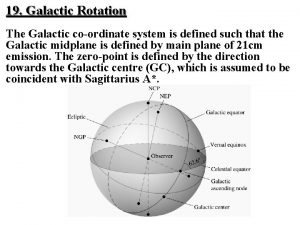Study of the Galactic structure and halo dark

























































- Slides: 57

Study of the Galactic structure and halo dark matter by Gravitational microlensing • Galactic halo • Galactic center Takahiro Sumi STE lab. , Nagoya University

Gravitational “Macro”lensing

Gravitational “Macro”lensing

Gravitational “Micro”lensing star arcsec. lens G If a lens is a size of a star, elongation of images is an order of 100 arcsec. G Just see a star magnified observer distortion of space due to gravity

Plastic lens

Single lens

Application of microlensing l Extra galactic 1, halo dark matter of lens galaxy(QSO variability) l Galactic 1, Galactic halo dark matter(towards the LMC & SMC) 2, Galactic center structure (towards the Bulge) 3, exoplanet (towards the Bulge)

WMAP result Dark energy =0. 74 Dark matter DM=0. 22 B=0. 04 Baryon 4%: Stars: 7% Neutral gas: 2% Cluster hot gas: 3% Unknown (warm gas? ): 88%

Galactic rotation curve & dark 11 matter M~3 x 10 M (R<100 kpc) Dark Matter Kepler: v 2=GM/r

Halo Dark Matter & Paczynski’s Idea G 20〜 40 times more dark matter than visible mass. (Paczynski 1986) G MAssive Compact Halo Objects (MACHOs) WINPs • MACHO can be observed by Microlensing. • 〜10−6 need to observe 1 M stars!

MACHO project Mt. Stromlo 1. 28 m telescope (1990~2000) 12 million stars

First Microlensing event by MACHO & EROS in 1993

results toward LMC MACHO 5. 7 yrs: 12 events M~0. 5 M 16% of the mass of a Standard Galactic halo. EROS 5 yrs : 0 event f<25% of the halo dark matter made of MACHO with 10 -7 -10 M f< 10% for 3. 5× 10 -7 -100 M OGLE-II 4 year: 3 event (1 in SMC) f<20% for 0. 4 M f<11% for 0. 003 -0. 2 M OGLE-II (Wyrzykowski et al. 2010) Tisserand et al. 2006

That is: • MACHOs are not major component of Galactic halo dark matter but MACHOs exist as many as visible objects!?

Degeneracy in parameters Einstein crossing time:

Bottom line: • There are lens objects towards LMC but Are they really in the halo?

Halo Dark Matter? or Self-lensing?

MEGA project Andromeda galaxy(M 31) Far side l results(preliminary): l 14 events l f<30%

Super. MACHO 4 m telescope, 1/2 nights for 3 months over 5 years. ~30 events LMC Event rate Self-lensing in LMC Halo MACHO Center Outer results(preliminary): 25 events (microling+SN) Self-lensing is negligible f<30%

Super. MACHO v. s. Super Nova

MOA (since 1995) (Microlensing Observation in Astrophysics) ( New Zealand/Mt. John Observatory, Latitude: 44 S, Alt: 1029 m )

New Zealand If. Ifyou youwanttotovisit. NZ NZfree, jointoto. MOA contact: sumi@stelab. nagoya-u. ac. jp

MOA (until ~1500) (the world largest bird in NZ) l height: 3. 5m l weight: 240 kg l can not fly l Extinct 500 years ago (Maori ate them)

MOA-II 1. 8 m telescope Mirror : 1. 8 m CCD : 80 M pix. FOV : 2. 2 deg. 2 First light: 2005/3 Survey start: 2006/4

Observational targets event rate: LMC, SMC : ~2 events/yr ( ~10 -7 ) ~500 events/yr ( ~10 -6 ) Bulge : Planetary event : ~10 -2 8 kpc, GC 50 kpc LMC

Observation towards LMC by MOA-II ~3 obs/night ~10 obs/night

Difference Image Analysis (DIA) Observed subtracted

Other constraints on MACHOs Gravitational microlensing: u EROS and MACHO (LMC) u Variability in lensed QSO Excluded (in M ): Schmidt et al ’ 98 10 -7 <M< 10 -1 Dynamical constraint (Carr & Sakellariadou ’ 99) Requiring an universality of the Galaxy! u open & globular clusters u binary stars u solar system objects u impact on Earth 103 <M<106 100 <M<107 10 -3<M M<10 -13 halo M<10 -12 disk

Microlensing of QSOs image A macrolens QSO image B microlenses

SUb-Lunar-mass Compact Objects (SULCOs) -14 -12 -10 Log(WCO) 0 -1 -2 g -8 Log(M/Ms) MACHO -16 Unconstrained Black hole annihilation -16 -7 CDM = SULCOs 10 <M<10 ?

Constraint on MACHOs in cosmology Current limit on compact objects in universe from lensing studies (1)microlensing of QSO Dalcanton, et al ’ 94 (2, 4)multiple image of compact radio sources. Wilkinson et al ’ 01 Augusto ’ 01 (3)multiple gamma-ray bursts Nemiroff et al ’ 01 (5)multiple image of QSO Nemiroff 91

Two windows SUb-Lunar-mass Compact Objects (SULCO) MAssive Stellar-mass Compact Objects (MASCO) (10 -13) <M<10 -7 M 102 <M< 104 M planetesimal, PBH primordial stars, BH, PBH

Summary 1 l MACHOs are not major component of Galactic halo dark matter (<20%) l There are lens objects towards LMC l Are they really in the halo? l MOA-II is trying to solve this problem l Two windows for MACHOs (SULCO, MASCO)

Galactic center

Galactic Bar θ 8 kpc lde Vaucouleur, 1964, gas kinematics l. Blitz&Spergel, 1991, 2. 4 IR luminosity asymmetry l. Weiland et al. , 1994, COBE-DIRBE, confirmed the asymmetry. l. Nakada et al. , 1991, distribution of IRAS bulge stars l. Whitelock&Catchpole, 1992, distribution of Mira l. Kiraga &Paczynski, 1994 Microlening Optical depth

COBE-DIRBE all Weiland et al. , 1994, confirmed the asymmetry. extinction correct disk subtracted

Optical Gravitational Lensing Experiment (OGLE) Las Campanas Altitude: 2300 m Seeing ~ 1. 3” OGLE-I : 1991~1996 : 1 m, 2 kx 2 k CCD OGLE-II : 1997~2000 : 1. 3 m, 2 kx 2 k CCD, 14’x 14’ OGLE-III: 2001~ : 1. 3 m, 8 kx 8 k mosaic CCD : 35’x 35’ 19 events 500 events 600 events/yr

Pieces of information G Microlensing Optical depth, and Event Timescale, t. E=RE/Vt, (Sumi et al. 2006) G Brightness of Red Clump Giant (RCG) and RRLyrae stars, (Stanek et al. 1997, Sumi 2004; Collinge, Sumi & Fabrycky, 2006) G Proper motions of RCG, (Sumi, Eyer & Wozniak, 2003; Sumi et al. 2004), Proper motion of 5 M stars, I<18 mag, ~1 mas/yr

1, the Galactic Bar structure (face on, from North) 8 kpc Obs. G. C.

1, the Galactic Bar structure (face on, from North) 8 kpc Obs. G. C. 1, Microlensing Optical depth, (Alcock et al. 2000; Afonso et al. 2003; Sumi et al. 2003; Popowski et al. 2004; Hamadache et al. 2006; Sumi et al. 2006) M=1. 6 1010 M , axis ratio (1: 0. 3: 0. 2), ~20

2. Red Clump Giants G Metal-rich horizontal branch stars G Small intrinsic width in luminosity function (~0. 2 mag) =20 -30 , axis ratio 1: 0. 4: 0. 3 Stanek et al. 1997

RCG by IR (Babusiaux & Gilmore, 2005) Deep survery by Cambridge IR survery instrument (CIRSI) =22 5. 5

3. Streaming motions of the bar with RCG Sumi (Princeton) , Eyer (Geneva Obs. ) & Wozniak (Los Alamos), 2003 Sun Color Magnitude Diagram faint bright Vrot=~50 km/s Sumi, Eyer & Wozniak, 2003

summary2 G All three results are consistent with the Bar with G G M=1. 6 1010 M (Md=0. 7 x 1010) axis ratio (1: 0. 3: 0. 2) =20 , (Han & Gould, 1995) Vrot~50 km/s • Little space for Dark Matter • Prefer Core than cusp dark matter (Binney & Evans 2001) MOA-II constrain stronger observation Halo+disk Halo ρ∝r-α

Cusp-Core problem in cold dark matter (CDM) halo Dark matter density profile at center of galaxy & galaxy cluster: Cusp: ρ∝r -1. 5 or Core: ρ∝const? NFW universal density profile ρ∝r-1. 5 with central cusp (Navarro, Frenk& White 1997) Log(density) Simulation: Collisionless CMD reproduces nicely the observed large scale structure of the universe (r>>1 Mpc) Observation: rotation curve for CDM dominated Dwarf and low surface brightness (LSB)galaxies high surface brightness disc galaxies (Salucci 2001) have a density profile with flat central core. Log(radius)

Density profile of Milky way (Sofue et al. 2009) NFW(cusp) Burkert(core) Isothermal(core) bulge disk

Cusp-core problem in dwarf spirals to giant low surface brightness galaxies (CDM dominated in center) rotation curve of dwarf spiral DDO 47 Dark halo density in ESO 116+G 12 Observed simulation (NFW) Cusp (NFW) Core Prefer core (Moore et al. 1999; de Blok et al. 2000; Salucci & Burkert 2000; Salucci&Martin 2009)

Cusp-core problem in giant elliptical galaxies; (Baryon dominated in center ) Lensing image in 0047 -281 (Koopmans 2003) Observed galaxy subtracted Lensing probability with image separation Δθ (Lin & Chen 2009) Singular isothermal sphere Observation Cusp (NFW) Cusp, ρ∝r -1. 9 Core Prefer cusp

Cusp-core problem in giant elliptical galaxies & galaxy cluster; (Baryon dominated in center ) • Statistics of QSO multiple images (Wyithe, Turner & , Spergel 2001; Keeton & Madau 2001; Li & Ostriker 2001; Takahashi & Chiba 2001) • Arc statistics of clusters of galaxies (Bartelmann et al. 1998; Molikawa & Hattori 2001; Oguri , Taruya + Suto 2001, Oguri, Lee + Suto 2003) • Time-delay statistics of QSO multiple images (Oguri, Taruya, Suto + Turner 2002) l. X-ray observation of galaxy cluster ⇒ generally favor a steep cusp ( α~ -1. 5)

Cusp-core problem: solution Self interacting dark matter(Spergel & Steinhardt 1999 ): σ/m~1 cm 2/g (10 -(21− 24) cm 2 (Mx/Ge. V)) make core and spherical halo(Yoshida etal. 2000) Weaker interaction doesn’t work; larger interaction leads to halo core collapse on Hubble time (e. g. , Moore et al. 2000, 2002; Yoshida et al. 2002; Burkert 2000; Kochanek & White 2000)

Cusp-core problem: solution Barion-CDM interaction (BCDMIs) • Dynamical friction of substructure (El-Zant et al. 2001; Tonini et al. , 2006; Romano-Diaz et al. 2008) • Stellar bar-CDM interaction (Weinberg&Katz, 2002; Holley-Beckelmann et al. 2005) • Baryon energy fedback(Mashchenko et al. , 2006; Peirani et al. 2008) Nonsingular, trancated isothermal sphere (NTIS) Cosmological, from collapsend virialization (shapiro et al. 1999; Iliev&Shapiro, 2001) Explain core in rotation curves, but cannot explain the steep & cuspy center of massive galaxies favored by Lensing and X-ray observation (just seeing cuspy baryon? ).

the Milky Way rotation curve (HI, CO, optical, VERA) Mbulge=1. 8 x 1010 M , Rbulge=0. 5 kpc Mdisk=7 x 1010 M , Rdisk=3. 5 kpc Truncated Isothermal dark halo with h= 5. 5 kpc, vrot=200 km/s NFW(cusp) Burkert(core) Isothermal(core) (Sufue et al. 2009)

Summary l MACHOs are not major component of Galactic halo dark matter (<20%) except two windows (SULCO, MASCO) but there are lens objects towards LMC, important for astrophysical point of view l dark matter density profile in the galaxy may be core rather than cusp microlensing contribute to constrain


Microlensing by SULCOs in Galactic halo M 33 DM 33 = 790 kpc DLMC = 50 kpc Small source size 8*10 -9 (star radius /106 km) arcsec (Total event) ~103 for 10 -8 Ms, DT~103 sec ~1 for 10 -11 Ms , DT~1 sec For 80 hours obs. by SUBARU/Suprime-cam

MASCOs M=103 if WMASCO=Wm 2. 5 mas N=1. 7(M/104)-1 mas-2 A B C D Inoue & Chiba Ap. J ’ 03

Distribution of surface brightness resolution= 0. 025 mas
 Halo halo halo lo lo lo
Halo halo halo lo lo lo Dark matter and dark energy ppt
Dark matter and dark energy ppt In a dark dark town
In a dark dark town Galactic address
Galactic address Galactic city model
Galactic city model Swcombine
Swcombine Urban structure models
Urban structure models Urban realms model
Urban realms model Galactic center radio transients
Galactic center radio transients Active galactic nuclei
Active galactic nuclei Galactic habitable zone
Galactic habitable zone Active galactic nuclei
Active galactic nuclei Galactic phonics ure
Galactic phonics ure Galactic cap review
Galactic cap review Alessandro cardillo
Alessandro cardillo Galactic habitable zone
Galactic habitable zone Active galactic nuclei
Active galactic nuclei Galactic
Galactic Halo and horn effect in performance appraisal
Halo and horn effect in performance appraisal Pedikly
Pedikly Hematoma septal
Hematoma septal Halo enfermeria
Halo enfermeria Non invasive halo brace
Non invasive halo brace Oxigenoterapia introduccion
Oxigenoterapia introduccion Mpm háló
Mpm háló Halo plex
Halo plex Halo closed system drug transfer device
Halo closed system drug transfer device Perfil toxemico
Perfil toxemico カンジダ症状 写真
カンジダ症状 写真 The halo effect
The halo effect Halo ortez
Halo ortez Panniculite mésentérique douleurs
Panniculite mésentérique douleurs Pert háló
Pert háló A gold halo signals that a figure is holy or sacred.
A gold halo signals that a figure is holy or sacred. Halo 3 cinematics
Halo 3 cinematics Pescoo
Pescoo Selamat siang salam sejahtera
Selamat siang salam sejahtera Renal halo sign
Renal halo sign Halo en pediatria
Halo en pediatria Halo vape detector
Halo vape detector Halo nevus
Halo nevus Bucks traction
Bucks traction Halo 2 ai
Halo 2 ai Halo efekt
Halo efekt Halo efekt
Halo efekt Halo effect negotiation
Halo effect negotiation Massive compact halo objects
Massive compact halo objects Rusty halo effect
Rusty halo effect Efeito halo
Efeito halo Disztributív háló
Disztributív háló Cpm háló
Cpm háló Lerman non invasive halo
Lerman non invasive halo Tcryo
Tcryo Define deit
Define deit Buah sejati tunggal berdaging
Buah sejati tunggal berdaging Abnormal fetal brain ultrasound
Abnormal fetal brain ultrasound Scoliosis chair
Scoliosis chair Halo effect csf
Halo effect csf






